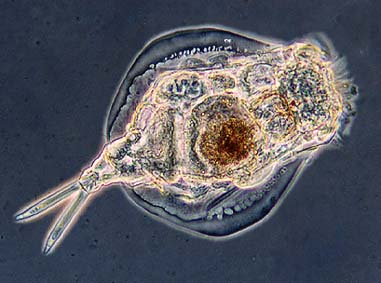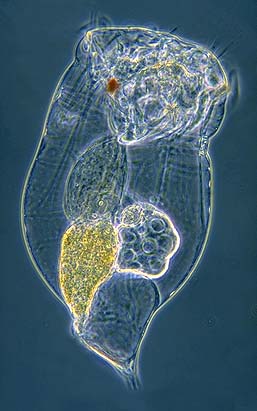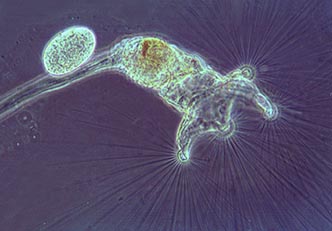
Euchlanis, a rotifer with a turtle- like shell (lorica) | ROTIFERS
by Wim van Egmond |

Euchlanis, a rotifer with a turtle- like shell (lorica) | ROTIFERS
by Wim van Egmond |
| Rotifers are multicelled
animals. Because they are so small most people have never heard of their existence.
They are about the same size as the larger unicellular organisms. They don't have
a lot of cells, less than 1000, but they have some very special attributes. They
are wonders of miniature design. At the front of the body they possess a crown of hair-like cilia. They locomote by using the crown of cilia (the corona) to propel themselves. Some species walk with head and foot. Their foot can secrete a sticky substance that enables them to attach to a surface. They also use the crown of cilia to wave food into their mouth. There the food is passed into the 'mastax' where two so-called 'trophi' process the food before it is directed towards the gut. Rotifers are so transparent that all these organs can be observed easily. They have one or two light sensitive red eye spots. There is an enormous variety of spectacular body shapes, all to suit the different lifestyles or environmental conditions. Because many species make so-called resting spores which are easily carried by the wind, they can be found anywhere if there is a little bit of water. Even in a roof gutter or in birdbaths. |  Synchaeta, a very transparent predatory rotifer. |

This Collotheca carries an egg near its foot | The
corona, the crown of cilia, can vary in design. Some species don't use it for
locomotion but have developed very special capturing devices. The
rotifers from the genus Collotheca live attached to a substrate and collect
tiny microbes like bacteria with extremely elongated cilia. To see these anglers
under the microscope is a beautiful sight. If you like to see more click the thumbnail for a gallery of rotifer images |
| Read the following MICSCAPE articles to find out more about a variety of rotifers |
| The rotifer jaw - a look at the jaws of the rotifer Brachionus |
or visit Wim's HOME PAGE
Microscopy
UK Front Page
Micscape
Magazine
Article
Library
all material © Wim van Egmond